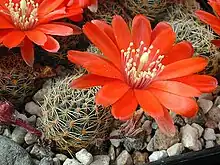| Aylostera pygmaea | |
|---|---|
 | |
| Scientific classification | |
| Kingdom: | Plantae |
| Clade: | Tracheophytes |
| Clade: | Angiosperms |
| Clade: | Eudicots |
| Order: | Caryophyllales |
| Family: | Cactaceae |
| Subfamily: | Cactoideae |
| Tribe: | Cereeae |
| Subtribe: | Rebutiinae |
| Genus: | Aylostera |
| Species: | A. pygmaea |
| Binomial name | |
| Aylostera pygmaea | |
| Synonyms[1] | |
|
List
| |
Aylostera pygmaea, synonyms including Rebutia pygmaea, is a species of cactus in the genus Aylostera, native to Bolivia and northwest Argentina.[1] It has gained the Royal Horticultural Society's Award of Garden Merit.[2]
Description
Aylostera pygmaea rarely grows alone, but most often produces abundant shoots with spherical, depressed spherical or cylindrically elongated bodies. The bodies reach heights of up to 6 centimeters with diameters of 0.5 to 4 centimeters and have a strong beet root. The 9 to 15 ribs are hardly divided into cusps. The areoles are circular. The central spine, which can also be missing, is protruding and short. The 2 to 11 marginal spines are white to brownish. They radiate laterally, rest against the surface of the body or slightly protrude and are 2 to 6 millimeters long.
The yellow to golden yellow, orange, orange-red, pink or violet, rarely flamed flowers are 1.6 to 2.7 centimeters long. The spherical fruits are greenish and have a diameter of up to 6 millimeters.
References
- 1 2 3 "Aylostera pygmaea (R.E.Fr.) Mosti & Papini". Plants of the World Online. Board of Trustees of the Royal Botanic Gardens, Kew. Retrieved 1 October 2023.
- ↑ "Rebutia pygmaea". The Royal Horticultural Society. Retrieved 15 November 2020.